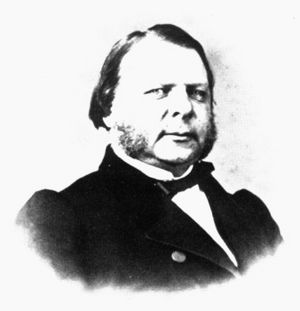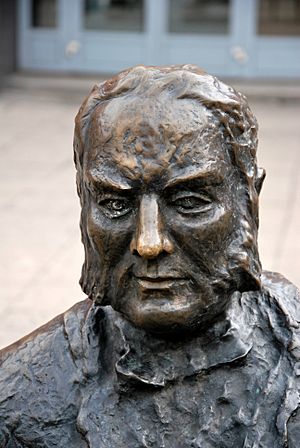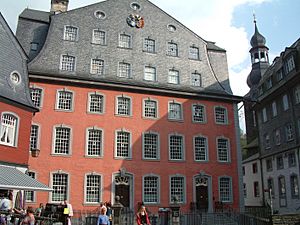Karl Wilhelm Scheibler facts for kids
Quick facts for kids
Karl Wilhelm Scheibler
|
|
|---|---|

Karl Wilhelm Scheibler
|
|
| Born | 1 September 1820 Monschau, Prussia
|
| Died | 13 April 1881 (aged 60) Łódź, Congress Poland
|
| Nationality | German, Polish |
| Occupation | Industrialist, textile magnate |
Karl Wilhelm Scheibler, also known as Karol Scheibler (born September 1, 1820 – died April 13, 1881), was a very important businessman and factory owner. He was born in Germany but became a famous textile maker in Poland. He helped build up the city of Łódź into a major industrial center.
Contents
Early Life and Education
Karl Scheibler came from a family that made textiles (cloth). He was born in a part of Germany called Prussia. He went to school in Monschau and Krefeld. After school, he learned how to work in a factory from his uncle in Verviers, Belgium. This was a practical way to learn about making cloth. In 1839, he even worked for a famous company called John Cockerill, which built machines.
Moving to Poland
In 1848, there were many protests and riots across Europe, known as the Spring of Nations. Because of these troubles, Scheibler decided to leave Germany. He moved to Ozorkow in Congress Poland. His uncle, Friedrich Schlösser, already had a textile factory there since 1816. After his uncle passed away, Karl became the manager of the factory.
On September 16, 1854, Scheibler married Anna Werner, who was his uncle's niece.
Building a Business in Łódź
In 1852, Karl Scheibler and his business partner, Julius Schwartz, bought some land in Łódź. They started to build a factory there. By October 1854, Scheibler bought out Schwartz's share for 10,000 rubles. This made him the only owner of the factory.
In 1855, Scheibler opened a spinning mill. This mill used 34 spinning frames and a powerful 40-horsepower steam engine. By 1857, Scheibler's factory had 180 workers.
The "King of Cotton"
Scheibler's business grew very quickly. He made a lot of money when cotton prices went up in Europe. This happened because of the American Civil War, which made it harder to get cotton. Scheibler sold his cotton stock for three times the price he paid! This success earned him the nickname "King of the Cotton and Linen Empires of Łódź."
By 1870, his factory was very large, employing 1,911 people. It was the third biggest cotton producer in all of Poland.
Expanding the Empire
Scheibler's factory continued to do well, and he bought several smaller mills. In 1874, a fire destroyed his factory at a place called Księży Młyn. But Scheibler didn't give up! He rebuilt it even bigger, with 88,000 spindles for spinning thread.
He also built his own "kingdom" at Księży Młyn. This wasn't a real kingdom, but a whole community for his workers. It included:
- Houses for 321 families
- A fire station
- Schools
- Shops
- A hospital
In 1880, he turned his company into a stock corporation. This meant that people could buy shares in his company, and it had a large capital of 9 million rubles.
Later Life and Legacy
Karl Scheibler passed away on April 13, 1881, in Łódź. He was buried in a grand mausoleum at the Protestant Cemetery of Łódź. The mausoleum was designed by famous architects Joseph Dziekonski and Edward Lilop.
Today, Scheibler's legacy lives on. The famous Polish movie The Promised Land was filmed inside Scheibler's Palace. This beautiful palace is now the Museum of Cinematography, part of the National Film School in Łódź.
Awards and Recognition
Karl Scheibler received several important awards for his contributions:
- 1870: Order of the White Eagle
- 1876: Gold Medal in Warsaw
- 1878: Great Gold Medal at the Paris World's Fair
- Order of Saint Stanislaus First and Second class
Images for kids






